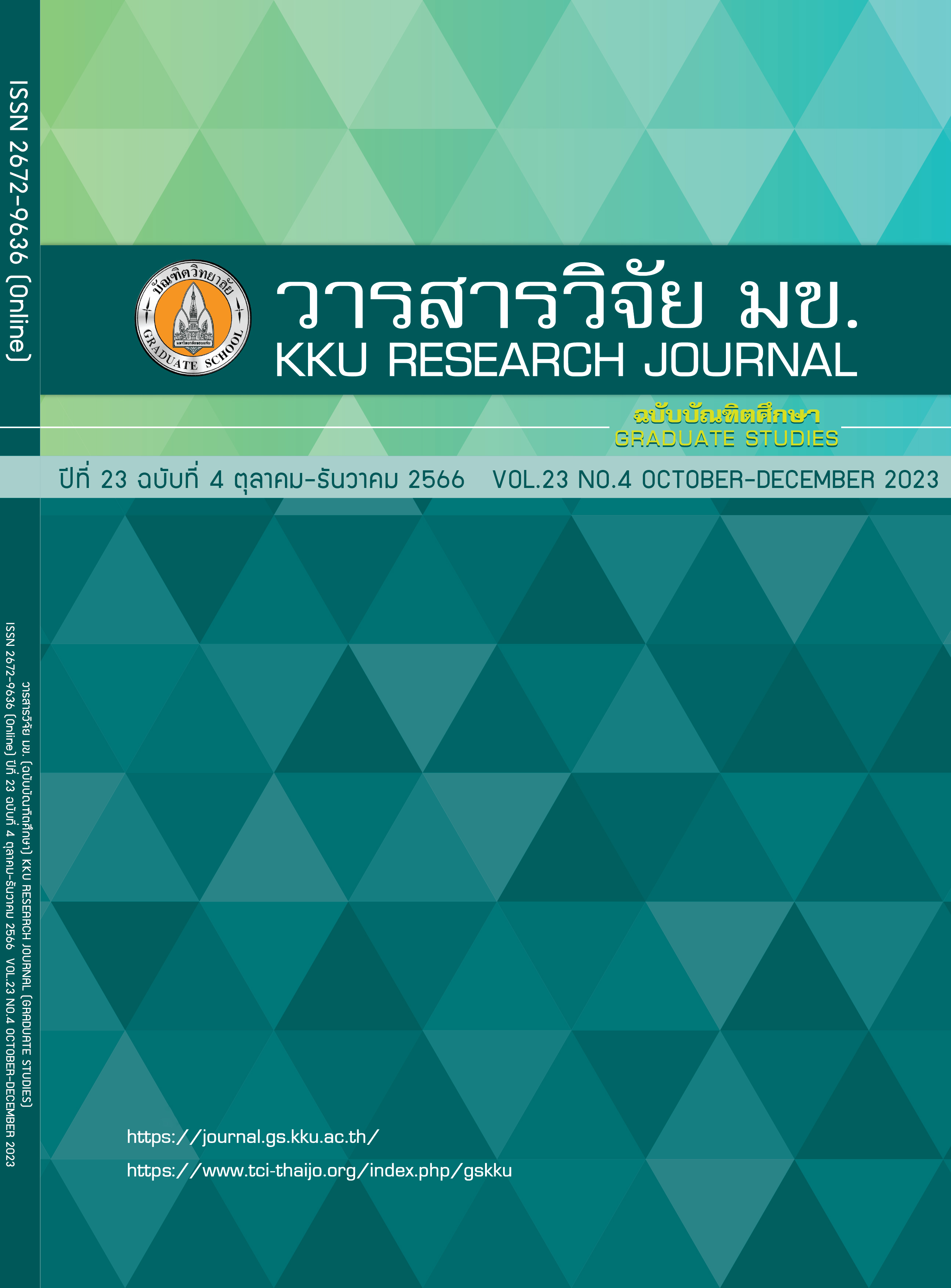Prediction of Wind Turbine Noise using SPSS Modeler
Keywords:
Noise prediction model, SPSS, Wind turbine noiseAbstract
IBM SPSS Modeler was used to develop a noise prediction model for the wind power plant located in Nakhon Ratchasima province, Thailand. Four individual models (CHAID, CART, Linear, and Neural network) and their ensemble were developed and compared. The model's inputs are distance, time, wind speed, wind direction, temperature, humidity, and pressure. The output is the equivalent sound pressure level. From the field measurement, the average sound level (43.0-47.8 dB(A)) was higher for the measurement point closer to the wind turbine. The measured sound at various times of the day shows higher sound levels in the morning and evening, indicating the effect of human activity. The most suitable technique was the Ensemble model, where the cross-validation for training and testing provides RMSE (10.08%) and MAE (5.89%).
References
Watts GR, Pheasant RJ. Identifying tranquil environments and quantifying impacts. Applied Acoustics. 2015;89:122-127.
Organization WH. Compendium of WHO and other UN guidance on health and environment. World Health Organization; 2022.
Shaltout ML, Yan Z, Palejiya D, Chen D. Tradeoff analysis of energy harvesting and noise emission for distributed wind turbines. Sustainable Energy Technologies and Assessments. 2015;10:12-21.
Nedic V, Cvetanovic S, Despotovic D, Despotovic M, Babic S. Data mining with various optimization methods. Expert Systems with Applications. 2014;41(8):3993-3999.
International Electrotechnical Commission [Internet]. IEC61672-1 Electroacoustics Sound level meters Part 1: Specifications 2013 [cited 2023 March 19]. Available from: https://webstore.iec.ch/publication/5708.
McAleer S, McKenzie A. Guidance note on noise assessment of wind turbine operations at EPA licensed sites (NG3). Environmental Protection Agency, Office of Environmental Enforcement. 2011.
Chicco D, Warrens MJ, Jurman G. The coefficient of determination R-squared is more informative than SMAPE, MAE, MAPE, MSE and RMSE in regression analysis evaluation. PeerJ Computer Science. 2021;7:e623.
Ralević N, Glišović NS, Djaković VD, Andjelić GB, editors. The performance of the investment return prediction models: Theory and evidence. 2014 IEEE 12th International Symposium on Intelligent Systems and Informatics (SISY); 2014: IEEE.
The International Business Machines Corporation [Internet]. Gains Charts 2021 [cited 2023 March 19]. Available from: https://www.ibm.com/docs/en/spss-modeler/saas?topic=gains-charts.
The International Business Machines Corporation [Internet]. Overview of Nodes 2021 [cited 2023 March 19]. Available from: https://www.ibm.com/docs/en/spss-modeler/saas?topic=SS3RA7_sub/modeler_mainhelp_client_ddita/clementine/clef_nodes_intro.htm.
U.S. Environmental Protection Agency Office of Noise Abatement and Control [Internet]. Information on levels of environmental noise requisite to protect public health and welfare with an adequate margin of safety 1974 [cited 2023 March 19]. Available from: https://www.nonoise.org/library/levels74/levels74.htm.
Pongpirul K. Noise-induced hearing loss (NIHL) and sound control standards for stone crushers (P. 225). Chulalongkorn Medical Journal. 2020;64(2):225-230.
Nguyen QH, Ly H-B, Ho LS, Al-Ansari N, Le HV, Tran VQ, et al. Influence of data splitting on performance of machine learning models in prediction of shear strength of soil. Mathematical Problems in Engineering. 2021.
Kim KI, Simon R. Overfitting, generalization, and MSE in class probability estimation with high‐dimensional data. Biometrical Journal. 2014;56(2):256-269.
Alam W, Aribam B, Singh WR. GIS based Assessment of Noise Environment of Imphal City, Manipur (India): A Comprehensive Study. Universal Journal of Environmental Research & Technology. 2018;7(1).
Bošnjaković M, Katinić M, Santa R, Marić D. Wind Turbine Technology Trends. Applied Sciences. 2022;12(17):8653.
Sagi O, Rokach L. Ensemble learning: A survey. Wiley Interdisciplinary Reviews: Data Mining and Knowledge Discovery. 2018;8(4):e1249.
Xiao Y, Wu J, Lin Z, Zhao X. A deep learning-based multi-model ensemble method for cancer prediction. Computer methods and programs in biomedicine. 2018;153:1-9.
Kavyanifar B, Tavakoli B, Torkaman J, Mohammad Taheri A, Ahmadi Orkomi A. Coastal solid waste prediction by applying machine learning approaches (Case study: Noor, Mazandaran Province, Iran). Caspian Journal of Environmental Sciences. 2020;18(3):227-236.
Chou J-S, Pham A-D. Enhanced artificial intelligence for ensemble approach to predicting high performance concrete compressive strength. Construction and Building Materials. 2013;49:554-563.
Li Y, Yao J, editors. The quantity prediction of 4G customers of China mobile communications corporation based on SPSS modeler. 2016 International Conference on Logistics, Informatics and Service Sciences (LISS); 2016: IEEE.
ABDAR M. A survey and compare the performance of IBM SPSS modeler and rapid miner software for predicting liver disease by using various data mining algorithms. Cumhuriyet Üniversitesi Fen Edebiyat Fakültesi Fen Bilimleri Dergisi. 2015;36(3):3230-3241.
Downloads
Published
Issue
Section
License
Copyright (c) 2023 KKU Research Journal (Graduate Studies)

This work is licensed under a Creative Commons Attribution-NonCommercial-NoDerivatives 4.0 International License.



